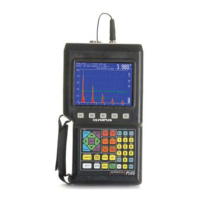62
EPOCH 4PLUS
diameter of 0.25" (6 mm). The calibration requires a test block with two known
thicknesses, made from the material to be measured. Ideally, the two thicknesses should
represent thicknesses that are both below and above the expected thickness of the material
to be inspected.
For this example, we are using Olympus NDT standard 5-step steel test block part number
2214E. It has steps measuring 0.100", 0.200", 0.300", 0.400", and 0.500".
Note: If the EPOCH 4PLUS is set to work in metric units, the calibration process is
exactly the same, except that the entries below will be in millimeters, rather
than inches.
Note: Due to the acoustic characteristics of dual transducers, a non-linearity in the
distance calibration occurs as the thickness of the material decreases. The
point of maximum sensitivity is determined by the “roof angle” of the
particular dual transducer.We recommend that the distance calibration is
carried out using a step block that covers the range of interest. Be careful
when interpreting thickness readings made outside the calibrated range. The
EPOCH 4PLUS does not have V-Path Correction; therefore, there may be
some non linearity within the calibrated range depending on the minimum
thickness used in the calibration process.
The zero offset value of dual element transducers can vary significantly at
extreme temperatures. If the temperature changes more than a few degrees
from the temperature at which the zero offset value was established, re-
check its value. If thickness measurements are to be made over a wide
temperature range, we strongly recommend the use of Olympus NDT dual
transducers that are designed for high temperature applications and that have
built-in delay lines with a stable sound velocity that does not change
significantly with temperature. Specific recommendations are Olympus
NDT D790-SM and D791 dual element transducers.
To calibrate using a Dual Element transducer, follow these steps:
1. Follow the initial set-up procedure outlined in Section 7.2.
Connect the transducer to an appropriate cable and then connect the cable to the
transducer posts on the EPOCH 4PLUS. Change the Test mode to Dual. Also, when
using a dual element transducer, the Gain setting is generally set very high so that the
leading edge of the backwall echoes appear as nearly vertical lines on the screen. The
leading edge is then used when making thickness measurements. For this reason, the
EPOCH 4PLUS should be set to EDGE Detection mode.
2. Press [CALIBRATION]. A Cal symbol appears to the right of the A-Scan, signifying
the EPOCH 4PLUS is in the Auto-Calibration mode. To exit the Auto-Calibration
mode at any point, press [ENTER].
3. Couple the transducer to the THIN calibration block step. For this example, the
transducer will be coupled to the 0.100" step. As noted above, a higher Gain setting is
required to produce a clean leading edge of the signal. Do not be concerned with the
jagged peaks of the echo. Concentrate on the leading edge only.

